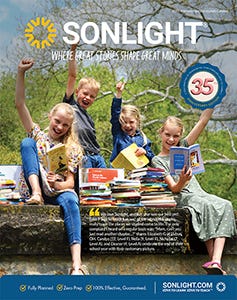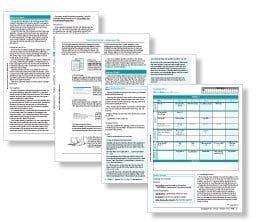We use cookies for performance, analytics and marketing. By using this site, you agree to our use of cookies. For more information, view our Cookie Notice and Privacy Policy.
Homeschooling with Excellence no. 15
Fun Teaching Activities
In this article we have included some fun teaching activities that were shared in the Sonlight community. If you like activities like these, check Sonlight Connections regularly because there is always something new!
Making Phonics Fun
How about making an alphabet book? Cut out pictures that begin with the letter you are working on and paste them on a sheet in a folder.
Roll letters out of playdough.
Fill a dish soap container with water and squirt letters on the driveway or sidewalk. In the winter I filled the container with colored water and had the kids write in the snow. My yard looked like one huge snow cone.
Write letters on your child's back and have her guess which one.
Have her try to form a letter using her body. This one was a real hit with my daughter. It was funny to see her on the floor with arms and legs sticking out everywhere.
Vocabulary Building Games
We tend not to worry too much about vocab building exercises. What works the best for us are some games that our family plays naturally.
One of them is the synonym game. My husband and I spent much of our dating life trying to top one another with better words for any expression. When we were standing in the sweltering heat I said to him that I was extremely hot. He countered with, "Well, I am broiling." Then I replied, "I am roasting." Thirty minutes later we were still going. This became a ritual with us.
As the kids have come along, we have enjoyed watching them join in spontaneously. They are looking for ways to participate in something that is so obviously fun for us.
We also do the same with puns — Let's say someone starts to mention something related to fishing (like fishing for a compliment). Then one of us might add, "I'm not hooked on compliments." The other might continue, "Well, I'll bait you until you are." Then a reply might follow, "I won't be reeled in that easily." You get the idea.
The kids scream with laughter at these. And my older two (5th and 7th) play along pretty easily. My 7-year-old boy joined in the other day and we were floored. So fun to see them catch the power of language.
I also recommend Scattergories Jr. for vocabulary building and lots of reading and commenting on words as you read. Take one out that is new, and have everyone try to use it in the correct context. This is better than most of the workbooks for sure.
Drawing Party
My 10-year-old son wanted a drawing party, so I got sidewalk chalk and clean pavement, a long piece of butcher paper tacked to one wall for a mural, and had everyone bring a T-shirt, and I provided the fabric markers. I had plenty of paper, markers, colored pencils, and drawing books scattered around the patio, kitchen, and living room.
Making a Salt Relief Map
On an unbendable piece of cardboard (about 15x15 inches) draw the outline. Use pencil.
Make salt/flour dough:
- 1 part salt
- 2 parts flour
- Enough water to make a slightly sticky, but manageable dough.
(1 cup salt, 2 cups flour will make enough dough for two good sized maps.)
If you would like to color the dough to show differences in elevation or vegetation, add a little food coloring or tempera paint to the dough when you add the water.
Take the salt dough and press it into the outline you have drawn on the cardboard. Build up ridges for mountains, make depressions in the dough to show rivers, lakes, or other low spots. You might want to use tempera paint to paint bordering oceans, nations, etc.
Lay the map flat and let it dry overnight.
Activities for American History
You could have your kids do some leather crafts while listening, make paper teepees with decorations, make a Native American vest with decoration, and do some beading while studying Native Americans. Have them make a paper doll with colonial clothing, build Lincoln Log cabins, create villages with toys, make a Jacob's ladder, play marbles, and so on for colonial period, you could have them put all their possessions (or a lot anyway) into a pillowcase or small trunk and masking tape an area on the floor that relates to how much space they may have had when traveling by boat to America and make them stay there for a while, and so on. There are lots of ways to make it fun and relevant for a younger child. They'll get to it again later on where they'll remember more facts than you thought. Your library should have Brown Paper School books and other books that have ideas for "playing history."
George Washington's BreaKF1st
An example from what we're reading this year for History, "George Washington's BreaKF1st." My son researched and figured out exactly what G.W. loved to eat for breaKF1st. So we made them for him as a reward for his efforts to figure it out. My family also followed suit and made hoe-cakes in the middle of the afternoon to snack on the day we read the book. So you cover life-skills training by letting the kids read a recipe for corn griddle cakes and making it. This also covers measurements for Math. You could also let your kids dress in "costume" and act out some of the stories from George Washington's life. You could bring in Science by figuring out what things were going on in the field at the time George Washington lived (Benjamin Franklin and his inventions!) So you are also using your time-line. And then let's not forget map skills: where all these things took place-Geography! What was happening in the art world at that time? Music?
Egypt Party
We had an Egypt party yesterday. It was a blast! Here's what we did:
1.Archeological dig (My 10-year-old daughter wrote on a clay pot, I broke it and she and some friends put it out in the yard for the smaller kids to dig up. The kids then cleaned it off and pieced it together to figure out the message.)
Sugar cube pyramids with brown sugar and glue.
Makeup for the girls.
Wigs for the girls (from Edupress).
King Tut mask (from Edupress).
I made coloring books for each of the kids that came and I put their name on the cover in hieroglyphics so they had to decode it to find which one was theirs (from the internet).
The kids loved it, the moms did too.
African Rain Sticks
We made African rain sticks and then looked Africa up on the globe & read from Stories from Africa! Take an empty wrapping paper tube & decorate. The book I have suggested "painting" with watered down glue & sticking on tissue paper squares. We just painted them with regular paint & let dry. Then you take toothpicks (8-16, I found 16 makes the best sound, I put them perpendicular to each other about 1/2-1 inch apart) & poke all the way through the tube (leave room on either end of the tube to hold it, the toothpicks stick out!). I had to use a knife to poke holes for the toothpicks. Then cover the one end (they suggested wax paper with rubber bands, I had tinfoil & twist-ties) & put 1 cup uncooked rice inside (with a funnel) before closing the second end. They sound great & my kids had so much fun with them! You could clip the toothpicks that are sticking out and glue in place.
Teaching Home Economy (Practical Life Skills)
Pick some bright cotton material, and go for lots of straight edges. The big mistake is making the first project too involved, too artistic. That leads to frustration for everyone.
My oldest son wanted to learn to sew last year (he was 10), so I taught him the basics of cutting straight, using the machine, pinning, that sort of thing. Nothing really technical. We looked at the underside and all the machinery — very interesting to a boy. I did not use a curriculum, just figured out what he wanted to know then thought of ways to show him those things.
After that, I required schoolwork to come first, then he could "play" on the sewing machine. He makes puppets, simple bags, bean bags, and pillows. The hardest project so far was a flannel night shirt.
Our next project is shorts. I teach him in small bursts, a little every 3-4 months, rather than all in one big swoop.
Family Trivia Game
Ask all the various members of the family to compile lists of questions for a trivia game. ("What was the name of Susie's imaginary friend?" "What did Joe give Mark for Christmas last year?" or whatever. By getting input from all of the family, hopefully you can collect questions from all facets of life. Then someone can put them together onto cards, and you can play a game.
Chinese Name
When studying China this one is really fun. You type in your own name and birthdate and it will give your Mandarin name, what it means, and the Chinese characters. Fun!
It also tells you what Chinese year you were born in. I was born in the Year of the Rat! Whoopee!
The site also has some other Chinese language helps but I didn't check them out: Get your Chinese name.



